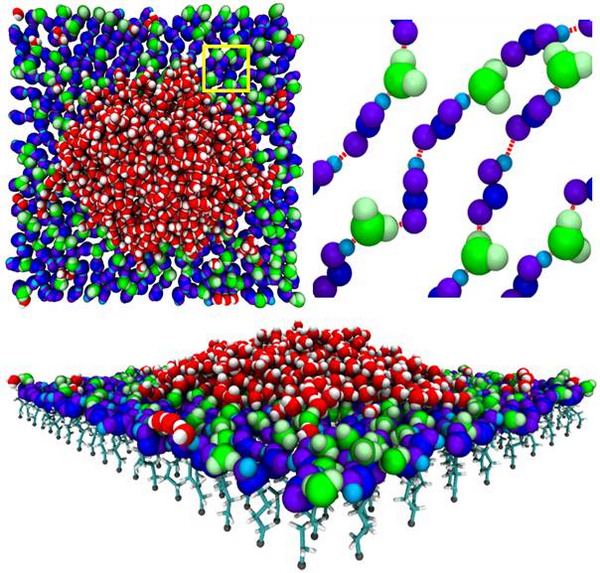Water-COOH Composite Structure with New Insight into Biological Water
Water is essential to life, as it constitutes seventy percent of the content of all living cells, within the structural formation, stability and function of proteins, nucleic acids and membranes, but it still remains little known how water engages, interacts with biomolecules, and even carries the biological functionalities. Even for the two dimensional biomimetic surfaces, e.g., the carboxyl-terminated self-assemble monolayers (COOH-SAMs), its interfacial behaviors of water can always not be understood well, though with numerous relevant experimental and theoretical efforts over the past 25 years.
SINAP researchers Pan Guo and Prof. Haiping Fang, collaborating with Prof. Yusong Tu at Yangzhou University, have recently combined molecular dynamics simulations and quantum mechanics calculations, and succeeded in demonstrating that water molecules can be embedded into the COOH matrix to form a composite structure on COOH-SAMs at room temperature. This composite structure enables COOH-SAMs to behave like a stable and integral surface with an integrated hydrogen bond network inside, reduces the hydrogen bonds with the water above to make an “apparent” enhancement of the hydrophobicity of COOH-SAM, though with super hydrophilic COOH groups. For the first time water is found to be able to embed into the surface and participate in the arrangement of the composite structure, and as inseparable part enclosed within this composite structure, embedded water becomes determinative to the wetting characteristics on COOH-SAMs. The results resolve a long-standing puzzle on seemingly contradictory experimental observations on COOH-SAMs in basic surface physics. More importantly, since the surface of COOH-SAMs with the flexible COOH-terminated alkyl chains is much analogous to a wide variety of biological surfaces, including membranes, and the COOH group itself occurs widely in biomolecules as a main component, the finding may provide a new perspective in understanding of how water becomes an active participant in interacting with biomolecules with finely tuning adaptation for the biological processes during the cell life and in stabilizing the surface of biological systems. The above results have been published in Physical Review Letters (PRL 115, 186101 (2015)).

Figure:The embedded-water–COOH composite structure formed by water molecules being embedded into the COOH matrix on COOH-SAMs with appropriate packing densities
This work is supported by Chinese Academy of Sciences, National Natural Science Foundation of China, the Computer Network Information Center of Chinese Academy of Sciences and the Shanghai Supercomputer Center of China.
Contact
Fang Haiping
Shanghai Institute of Applied Physics(SINAP),CAS
E-mail: fanghaiping@sinap.ac.cn 
